A Critical Review on the Feasibility of Synthetic Polymers Inclusion in Enhancing the Geotechnical Behavior of Soils
Abstract
1. Introduction
2. Synthetic Polymers Application in Geotechnical Engineering
2.1. Polyacrylamide (PAM)
2.2. Polyethylene (PE)
2.3. Polypropylene (PP)
2.4. Polyurethane (PU)
2.5. Polystyrene and Styrene Copolymer
2.6. Polyvinyl Acetate (PVA)
2.7. Polyvinyl Alcohol (PVAO)
2.8. Polyvinyl Chloride (PVC)
| Reference | Soil | Test | Factor Considered | Polymer Type |
|---|---|---|---|---|
| [94] | Silty Clay | Water erosion | Infiltration depth | Aqua-dispersing-nano-binder (ADNB) |
| Water stability | ||||
| [95] | Clay | Atterberg limit | Polymer content | CBR Plus |
| Compaction | ||||
| CBR | ||||
| [95,96] | Oedometer | |||
| [96] | UCS | |||
| [97] | Clay | UCS | Polymer content Curing time | Epoxy resin |
| Triaxial | ||||
| Split tensile strength | ||||
| [98] | Sand | Compaction | Polymer content | |
| Ultrasonic pulse velocity | Polymer content | |||
| Curing time | ||||
| Cement content | ||||
| UCS | Polymer content | |||
| Curing time | ||||
| Cement content | ||||
| [99] | Sand | Erosion | Polymer content | Interpolyelectrolyte Complexes (IPC) |
| [100] | Sand | Fatigue test | Polymer content | Methylene Diphenyl Diisocyanate (MDI) |
| UCS | Polymer content | |||
| Curing method | ||||
| Curing time | ||||
| Moisture content | ||||
| [101,102] | Clay | Free/volumetric swelling ratio | Polymer content | Polyacrylamide (PAM) |
| [101] | Sorption test | |||
| [102] | Atterberg limits | |||
| Compaction | ||||
| Oedometer | ||||
| [103] | UCS | Polymer content | ||
| Curing time | ||||
| Curing condition | ||||
| Direct shear | Polymer content | |||
| Curing time | ||||
| [102] | Soil reactivity | Polymer content | ||
| Cyclic wetting & drying | ||||
| Crack intensity | ||||
| [104] | Clayey sand with gravel | Compaction | Polymer content | |
| UCS | Polymer content | |||
| Curing time | ||||
| Hydraulic conductivity | Polymer content | |||
| Abrasion resistance | ||||
| Water erosion | ||||
| Durability | Capillary rise | |||
| [104] | Sandy clay | Compaction | Polymer content | |
| UCS | Polymer content | |||
| Curing time | ||||
| Hydraulic conductivity | Polymer content | |||
| Abrasion resistance | ||||
| Water erosion | ||||
| Durability | Capillary rise | |||
| [104] | Silty sand | Compaction | Polymer content | |
| [104,105] | UCS | Polymer content | ||
| [104,105] | Curing time | |||
| [104] | Hydraulic conductivity | Polymer content | ||
| [104] | Abrasion resistance | |||
| [105] | CBR | |||
| Curing time | ||||
| [104] | Water erosion | Polymer content | ||
| [104,105] | Durability | Capillary rise | ||
| [106] | Sand | Crust thickness & density | Polymer content | |
| Moisture retention | ||||
| [107] | Durability | Wet-dry cycles | ||
| Temperature | ||||
| U.V aging | ||||
| [106,107] | Penetration resistance | Polymer content | ||
| [106] | Wind erosion | |||
| [108] | Silt | Atterberg limits | Polymer content | |
| Compaction | ||||
| UCS | Polymer content | |||
| Curing time | ||||
| Curing condition | ||||
| Durability | Freezing thaw | |||
| [109] | Clay | Atterberg limits | Polymer content | Polyethylene (PE) |
| Compaction | ||||
| CBR | ||||
| Direct shear | ||||
| Oedometer | ||||
| [101] | Clay | Swelling test | Polymer content | Polyethylene oxide (PEO) |
| Sorption test | ||||
| [65,110,111] | Clay | Atterberg limits | Polymer content | Polypropylene (PP) |
| [65,110,111] | Compaction | |||
| [65,111] | Oedometer | Polymer content | ||
| [110] | Nanocomposite | |||
| Curing time | ||||
| [65,111] | UCS | Polymer content | ||
| [110] | Nanocomposite | |||
| Curing time | ||||
| [65] | Volumetric shrinkage | Polymer content | ||
| [65] | Desiccation cracks | |||
| [111] | Vane shear | |||
| [112] | Clay | Consolidation | Polymer content | Polyurethane (PU) |
| UCS | ||||
| Durability (Long & short term) | UV exposure | |||
| Wet-dry cycles | ||||
| Freeze–thaw cycles | ||||
| [113] | Sulfate rich clay | UCS | Polymer content, curing time | |
| Free swell | ||||
| [114,115,116] | Sand | Direct shear | Polymer content | |
| [114,115] | Density | |||
| [115,116] | Fiber content | |||
| [114,115,117] | Tensile strength | Polymer content | ||
| [117] | Curing time | |||
| [114,115,117] | Density | |||
| [115,117] | Fiber content | |||
| [114,115,116] | UCS | Polymer content | ||
| [114,115] | Density | |||
| [115,116] | Fiber content | |||
| [118] | Permeability | Polymer content | ||
| Curing time | ||||
| [119] | Clay | Atterberg limit | Polymer content | Polyvinyl acetate (PVA) |
| Direct shear | ||||
| UCS | ||||
| Triaxial | ||||
| Oedometer | ||||
| [120] | Wind erosion | |||
| [121] | Swell and shrinkage | |||
| [122] | Sandy clay | Atterberg limit | Polymer content | |
| Compaction | ||||
| Free swell index | ||||
| UCS | ||||
| [123,124] | Sand | Durability | Thermal aging | |
| [123] | Freeze–thaw cycles | |||
| [124] | Salt | |||
| Soaking | ||||
| Wet-dry cycles | ||||
| [123,124] | UCS | Polymer content | ||
| [124] | Curing time | |||
| [120,123] | Wind erosion | Polymer content | ||
| [120] | Silt | Wind erosion | Polymer content | |
| [125,126] | Clay | UCS | Polymer content | Polyvinyl alcohol (PVAO) |
| [125,126] | Curing time | |||
| [125] | Density | |||
| [125,126] | Durability | Polymer content | ||
| [125,126] | Soaking | |||
| [125,126] | Density | |||
| [109] | Clay | Atterberg limits | Polymer content | Polyvinyl chloride (PVC) |
| Compaction | ||||
| CBR | ||||
| Direct shear | ||||
| Oedometer | ||||
| [95] | Clay | Atterberg limit | Polymer content | Road Packer Plus (RPP) |
| Compaction | ||||
| CBR | ||||
| Oedometer | ||||
| [127] | Clay | Compaction | Polymer content | SoilTech MKIII |
| UCS | ||||
| CBR | ||||
| [128] | Sand | Durability | Outdoor exposure | Styrene-acrylic emulsion (SAE) |
| Wet-dry cycles | ||||
| Freeze–thaw cycles | ||||
| [129] | Soaking | |||
| [128,129] | UCS | Polymer content | ||
| [129] | Curing time | |||
| [128] | Flexural fatigue | Polymer content | ||
| [129] | Permeability | |||
| Moisture retention | Polymer content | |||
| Curing time | ||||
| [105] | Silty sand | CBR | Polymer content | |
| Curing time | ||||
| Durability | Capillary rise | |||
| UCS | Polymer content Curing time | |||
| [130] | Sand | Direct shear | Polymer content Fiber content | Styrene-butadiene rubber (SBR) emulsion |
| Modulus rupture | ||||
| Durability | Temperature | |||
| UCS | Polymer content | |||
| Fiber content | ||||
| [131] | Compaction | Polymer concentration | ||
| CBR | ||||
| Direct shear | ||||
| [132] | Clay | Cyclic oedometer | Cyclic swell | Urea Formaldehyde Resin/Melamine Urea Formaldehyde Resin (UFR/MUFR) |
| Polymer content | ||||
| [133] | Peat | UCS | Polymer content | |
| Curing time | ||||
| Durability | Soaking | |||
| [134] | Sand | UCS | Polymer content | |
| [135,136] | Clay | Atterberg limits | Polymer content | Vinyl copolymer |
| [135,136] | Compaction | |||
| [135] | Oedometer | Polymer content | ||
| Curing time | ||||
| Hydraulic conductivity | ||||
| [135,136] | UCS | Polymer content | ||
| [135,136] | Curing time | |||
| [136] | CBR | Polymer content | ||
| [123] | Sand | Durability | Thermal aging | |
| [123] | Freeze–thaw cycles | |||
| [129] | Soaking | |||
| [123,129] | UCS | Polymer content | ||
| [129] | Curing time | |||
| [129] | Moisture retention | Polymer content | ||
| [129] | Curing time | |||
| [129] | Permeability | Polymer content | ||
| [123] | Wind erosion | Polymer content |
3. Geotechnical Engineering Properties of Polymer Treated Soils
3.1. Atterberg Limit
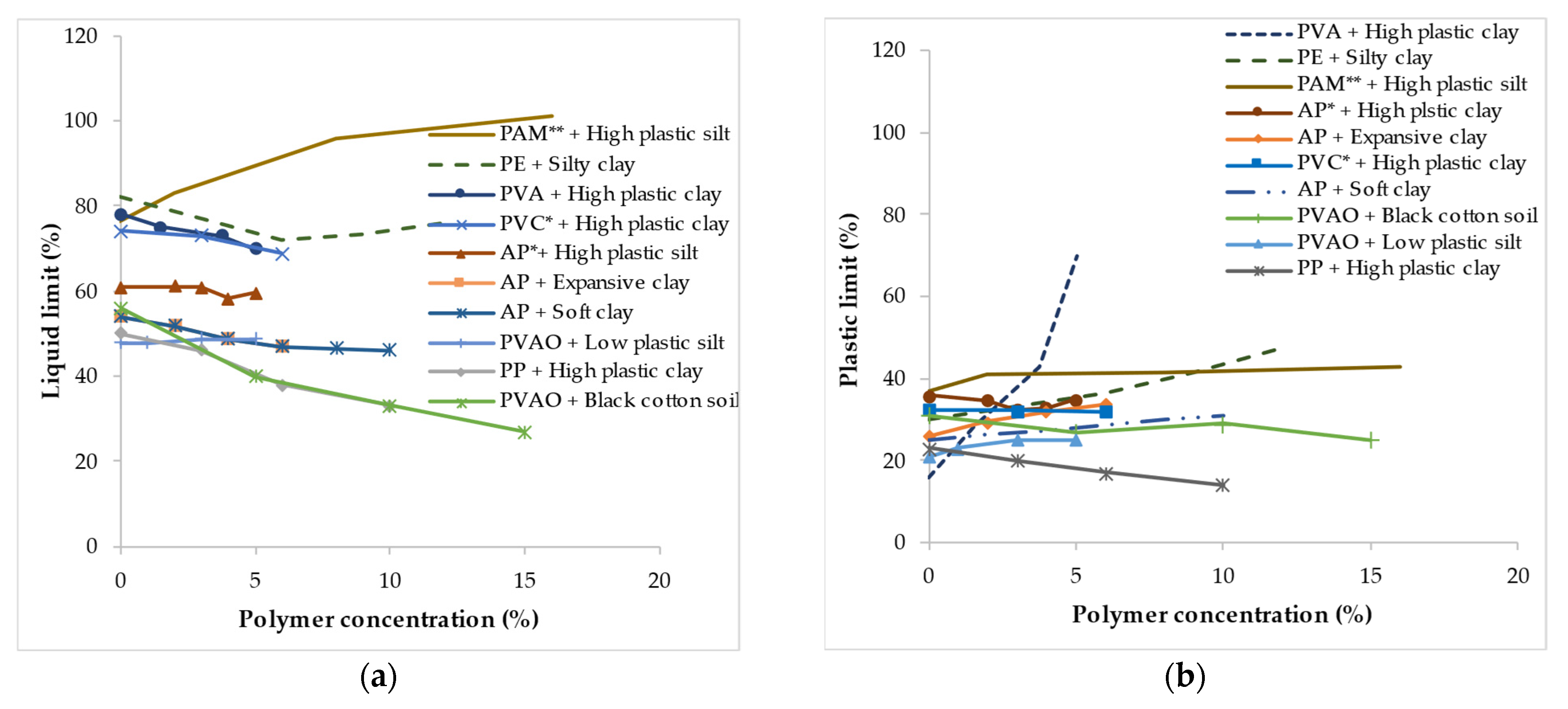
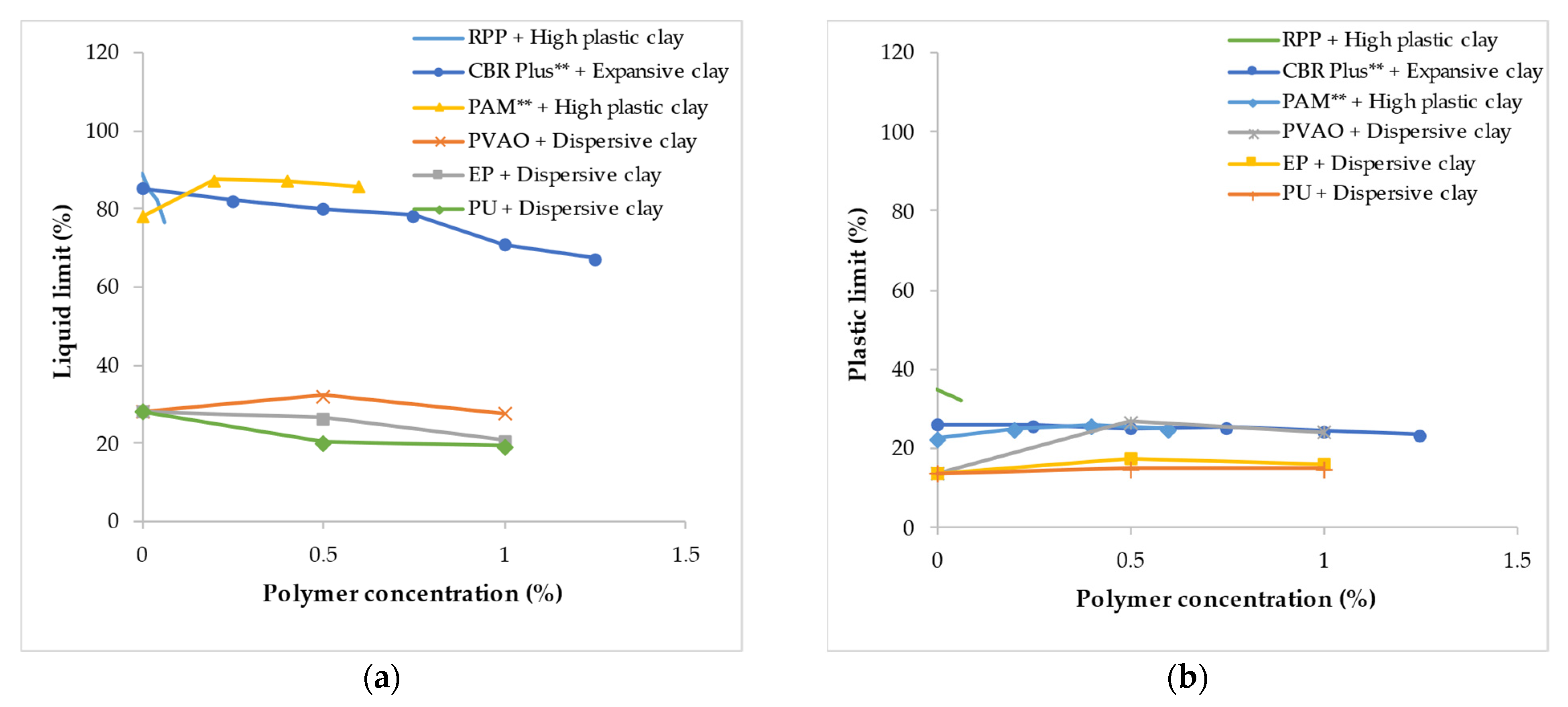
3.2. Compaction Characteristics
3.3. Strength
3.3.1. Unconfined Compressive Strength (UCS)
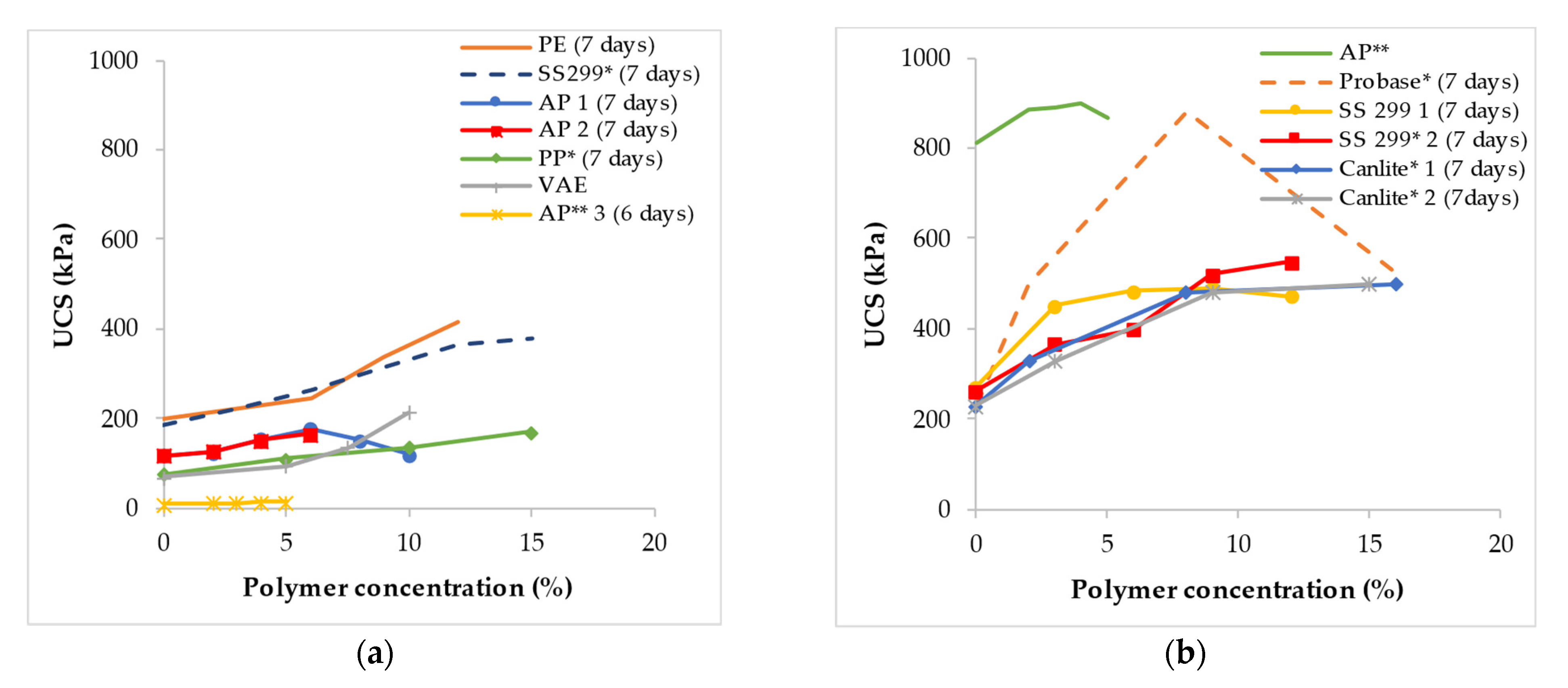
3.3.2. Direct Shear
3.3.3. California Bearing Ratio (CBR)
3.4. Hydraulic Conductivity
3.5. Sediment Volume Behavior
3.5.1. Volumetric Swell Ratio (VSR), Free Swell Ratio (FSR) and Free Swell Index (FSI)
3.5.2. Swell Characteristics (Swell Potential and Pressure)
3.5.3. Compression Index
4. Durability of Polymer Stabilized Soil
4.1. Freeze-Thaw Cycles
4.2. Photodegradation
4.3. Thermal Degradation
4.4. Wet-Dry Cycles
4.5. Water Stability and Soaking Test
4.6. Long Term Stability
4.7. Erosion Resistance
4.7.1. Water Erosion Resistance
4.7.2. Wind Erosion Resistance
5. Reinforcement Mechanism of Polymer-Soil Composite
5.1. Cohesionless Soil
5.2. Cohesive Soil
6. Conclusions
- The most widely used synthetic polymers in most geotechnical engineering application include PAM, PE, PU, PP, PVA, VC, AP, CBR plus, RPP, SS 299 and canlite.
- The soil-polymer interaction is dependent on the type of polymer, concentration, molecular weight, ionic charge, soil type, moisture content, curing period, water affinity, etc.
- The inclusion of a polymer in fine-grained soil can either increase, decrease, or have no significant impact on the Atterberg’s limits. Highly plastic clay when amended with PP polymer, can significantly reduce the Atterberg’s limits.
- Polymers play a significant role in altering the compaction characteristic of fine-grained soil following the formation of hydrophobic nanocomposite materials within the soil particles, which further act as nano-fillers. Application of VC and PP to fine-grained soil is effective in reducing the OMC and in increasing the MDD.
- The UCS of polymer-treated sand is found to improve significantly with polymer concentration. The increase in the strength has been linked to the formation of a polymer network membrane within the soil particles which improves the cohesive force between the soil particles resisting the shearing. The application of PE canlite, and VAE polymer to clayey soil; Probase, SS 299, and Canlite to silty soil; and SAE, PVA, PMMA, and SBR to sandy soil efficiently improves the UCS.
- The formation of a polymer network within the pore of a soil limits the seepage of water through the pores of the soil. The application of anionic PAM, VC, and PP to fine-grain soil and PAM, AP, SA, VA, and PU to sandy soil significantly reduces the hydraulic conductivity. Contrarily, VC polymer are found to increase the hydraulic conductivity of expansive clay.
- The reinforcement mechanism of both coarse and fine-grained soil treated with polymer includes pore filling, chemical reaction, and enwrapping. However, the chemical reaction of polymers with clay has been reported to be quite different from the case with coarse-grained soil. Cation exchange, electrostatic attraction, hydrogen bonding, van der Waals forces, and ion-dipole interactions are some of the mechanisms by which polymer molecules interact chemically with clay particle surfaces.
- The application of polymers to expansive clayey soil improves the volume stability and swell characteristics. Polymer such as POE, PAM, and PVA when amended with expansive clay, reduce the volumetric swell ratio (VSR), free swell ratio (FSR), and free swell index (FSI). Application of PP, PE, and PPMA to expansive clayey soil reduces the swell potential and pressure considerably.
- Certain polymers when treated with soil exhibit degradation in strength and stability when exposed to freeze- thaw, wet-dry cycles, and soaking because of their ability to absorb water, which results in the breakdown of polymer chain and resulting in the loss of strength. However, the application of PVA, VAEC, and PET polymer to sandy soil increases the durability against freeze-thaw action.
- The use of PVA and PMMA polymers to sandy soil enhances the thermal degradation. ADNB, AEE, crosslinked PAM-CMC, and PU are shown to exhibit excellent water stability under changing environments.
- PU, PAM, AEE, and VAE are effective in minimizing the water erosion, while PVA, PAM and PVAO have successfully been applied to significantly reduce soil mass loss.
Author Contributions
Funding
Data Availability Statement
Acknowledgments
Conflicts of Interest
References
- Kestler, M.A. Stabilization Selection Guide for Aggregate-and Native-Surfaced Low-Volume Roads; U.S. Department of Agriculture, Forest Service, National Technology & Development Program: Washington, DC, USA, 2009.
- Benhelal, E.; Zahedi, G.; Shamsaei, E.; Bahadori, A. Global Strategies and Potentials to Curb CO2 Emissions in Cement Industry. J. Clean. Prod. 2013, 51, 142–161. [Google Scholar] [CrossRef]
- Robayo-Salazar, R.; Mejía-Arcila, J.; de Gutiérrez, R.M.; Martínez, E. Life Cycle Assessment (LCA) of an Alkali-Activated Binary Concrete Based on Natural Volcanic Pozzolan: A Comparative Analysis to OPC Concrete. Constr. Build. Mater. 2018, 176, 103–111. [Google Scholar] [CrossRef]
- Makul, N. Principles of Low-Carbon Cement. In Principles of Cement and Concrete Composites; Springer: Berlin/Heidelberg, Germany, 2021; pp. 43–77. [Google Scholar]
- Vinod, J.S.; Indraratna, B.; Mahamud, M.A. Stabilisation of an Erodible Soil Using a Chemical Admixture. Proc. Inst. Civ. Eng.-Ground Improv. 2010, 163, 43–51. [Google Scholar] [CrossRef]
- Almajed, A.; Khodadadi Tirkolaei, H.; Kavazanjian, E. Baseline Investigation on Enzyme-Induced Calcium Carbonate Precipitation. J. Geotech. Geoenviron. Eng. 2018, 144, 04018081. [Google Scholar] [CrossRef]
- Almajed, A.A. Enzyme Induced Carbonate Precipitation (EICP) for Soil Improvement. Ph.D. Thesis, Arizona State University, Tempe, AZ, USA, 2017. [Google Scholar]
- Bang, S.S.; Bang, S.; Frutiger, S.; Nehl, L.M.; Comes, B.L. Application of Novel Biological Technique in Dust Suppression. In Proceedings of the Transportation Research Board 88th Annual Meeting, Washington, DC, USA, 11–15 January 2009. [Google Scholar]
- Chandra, A.; Ravi, K. Application of Enzyme Induced Carbonate Precipitation (EICP) to Improve the Shear Strength of Different Type of Soils. In IGC 2018; Indian Institute of Science: Bengaluru, India, 2018; p. 9. [Google Scholar]
- Kavazanjian, E.; Almajed, A.; Hamdan, N. Bio-Inspired Soil Improvement Using EICP Soil Columns and Soil Nails. In Grouting 2017; American Society of Civil Engineers: Honolulu, HI, USA, 2017; pp. 13–22. [Google Scholar] [CrossRef]
- Kavazanjian, E.; Hamdan, N. Enzyme Induced Carbonate Precipitation (EICP) Columns for Ground Improvement. In IFCEE 2015; American Society of Civil Engineers: San Antonio, TX, USA, 2015; pp. 2252–2261. [Google Scholar] [CrossRef]
- Meyer, F.D.; Bang, S.; Min, S.; Stetler, L.D.; Bang, S.S. Microbiologically-Induced Soil Stabilization: Application of Sporosarcina pasteurii for Fugitive Dust Control. In Geo-Frontiers 2011: Advances in Geotechnical Engineering; ASCE: Reston, VA, USA, 2011. [Google Scholar] [CrossRef]
- Krajewska, B. Urease-Aided Calcium Carbonate Mineralization for Engineering Applications: A Review. J. Adv. Res. 2018, 13, 59–67. [Google Scholar] [CrossRef] [PubMed]
- Anbu, P.; Kang, C.-H.; Shin, Y.-J.; So, J.-S. Formations of Calcium Carbonate Minerals by Bacteria and Its Multiple Applications. Springerplus 2016, 5, 250. [Google Scholar] [CrossRef]
- Ercole, C.; Bozzelli, P.; Altieri, F.; Cacchio, P.; Santacecilia, A.; Del Gallo, M. Exopolymeric Substances Involved in Calcium Carbonate Biomineralization and Their Use to Preserve and Restore Stone Monuments. Environ. Eng. Manag. J. 2012, 11, 85–90. [Google Scholar]
- Liu, R.; Huang, S.; Zhang, X.; Song, Y.; He, G.; Wang, Z.; Lian, B. Bio-Mineralisation, Characterization, and Stability of Calcium Carbonate Containing Organic Matter. RSC Adv. 2021, 11, 14415–14425. [Google Scholar] [CrossRef]
- Rebata-Landa, L.V. Microbial Activity in Sediments: Effects on Soil Behavior. Ph.D. Thesis, Georgia Institute of Technology, Atlanta, GA, USA, 2007. [Google Scholar]
- Al Qabany, A.; Soga, K. Effect of Chemical Treatment Used in MICP on Engineering Properties of Cemented Soils. Géotechnique 2013, 63, 331–339. [Google Scholar] [CrossRef]
- DeJong, J.T.; Fritzges, M.B.; Nüsslein, K. Microbially Induced Cementation to Control Sand Response to Undrained Shear. J. Geotech. Geoenviron. Eng. 2006, 132, 1381–1392. [Google Scholar] [CrossRef]
- Khamehchiyan, M.; Rowshanbakht, K.; Reza Nikudel, M.; Sajedi, R.H. Biological Improvement of Sandy Soil by Microbial Induced Carbonate Precipitation. J. Kerbala Univ. 2012, 8, 100–110. [Google Scholar]
- Mahawish, A.; Bouazza, A.; Gates, W.P. Improvement of Coarse Sand Engineering Properties by Microbially Induced Calcite Precipitation. Geomicrobiol. J. 2018, 35, 887–897. [Google Scholar] [CrossRef]
- Martinez, B.C.; DeJong, J.T.; Ginn, T.R.; Montoya, B.M.; Barkouki, T.H.; Hunt, C.; Tanyu, B.; Major, D. Experimental Optimization of Microbial-Induced Carbonate Precipitation for Soil Improvement. J. Geotech. Geoenviron. Eng. 2013, 139, 587–598. [Google Scholar] [CrossRef]
- Montoya, B.M.; DeJong, J.T. Stress-Strain Behavior of Sands Cemented by Microbially Induced Calcite Precipitation. J. Geotech. Geoenviron. Eng. 2015, 141, 04015019. [Google Scholar] [CrossRef]
- Van Paassen, L.A.; Ghose, R.; van der Linden, T.J.; van der Star, W.R.; van Loosdrecht, M.C. Quantifying Biomediated Ground Improvement by Ureolysis: Large-Scale Biogrout Experiment. J. Geotech. Geoenviron. Eng. 2010, 136, 1721–1728. [Google Scholar] [CrossRef]
- Whiffin, V.S.; Paassen, V.L.A.; Harkes, M.P. Microbial Carbonate Precipitation as a Soil Improvement Technique. Geomicrobiol. J. 2007, 25, 417–423. [Google Scholar] [CrossRef]
- Zhao, Q.; Li, L.; Li, C.; Li, M.; Amini, F.; Zhang, H. Factors Affecting Improvement of Engineering Properties of MICP-Treated Soil Catalyzed by Bacteria and Urease. J. Mater. Civ. Eng. 2014, 26, 04014094. [Google Scholar] [CrossRef]
- Jiang, X.; Rutherford, C.; Ikuma, K.; Cetin, B. Use of Biocementation for Slope Stabilization of Levees; Iowa State University: Ames, IA, USA, 2018. [Google Scholar]
- Maleki, M.; Ebrahimi, S.; Asadzadeh, F.; Tabrizi, M.E. Performance of Microbial-Induced Carbonate Precipitation on Wind Erosion Control of Sandy Soil. Int. J. Environ. Sci. Technol. 2016, 13, 937–944. [Google Scholar] [CrossRef]
- Mohebbi, M.M.; Habibagahi, G.; Niazi, A.; Ghahramani, A. A Laboratory Investigation of Suppression of Dust from Wind Erosion Using Biocementation with Bacillus Amyloliquefaciens. Sci. Iran. 2019, 26, 2665–2677. [Google Scholar] [CrossRef]
- Wang, Z.; Zhang, N.; Ding, J.; Lu, C.; Jin, Y. Experimental Study on Wind Erosion Resistance and Strength of Sands Treated with Microbial-Induced Calcium Carbonate Precipitation. Adv. Mater. Sci. Eng. 2018, 2018, 3463298. [Google Scholar] [CrossRef]
- Wang, X.; Tao, J.; Bao, R.; Tran, T.; Tucker-Kulesza, S. Surficial Soil Stabilization against Water-Induced Erosion Using Polymer-Modified Microbially Induced Carbonate Precipitation. J. Mater. Civ. Eng. 2018, 30, 04018267. [Google Scholar] [CrossRef]
- Ramachandran, S.K.; Ramakrishnan, V.; Bang, S.S. Remediation of Concrete Using Micro-Organisms. ACI Mater. J.-Am. Concr. Inst. 2001, 98, 3–9. [Google Scholar]
- Ramakrishnan, V.; Ramesh, K.P.; Bang, S.S. Bacterial Concrete. In Smart Materials; International Society for Optics and Photonics: Bellingham, WA, USA, 2001; Volume 4234, pp. 168–176. [Google Scholar]
- Lemboye, K.; Almajed, A.; Hamid, W.; Arab, M. Permeability Investigation on Sand Treated Using Enzyme-Induced Carbonate Precipitation and Biopolymers. Innov. Infrastruct. Solut. 2021, 6, 167. [Google Scholar] [CrossRef]
- Moghal, A.A.B.; Lateef, M.A.; Mohammed, S.A.S.; Ahmad, M.; Usman, A.R.; Almajed, A. Heavy Metal Immobilization Studies and Enhancement in Geotechnical Properties of Cohesive Soils by EICP Technique. Appl. Sci. 2020, 10, 7568. [Google Scholar] [CrossRef]
- Putra, H.; Yasuhara, H.; Kinoshita, N.; Erizal; Sudibyo, T. Improving Shear Strength Parameters of Sandy Soil Using Enzyme-Mediated Calcite Precipitation Technique. Civ. Eng. Dimens. 2018, 20, 91–95. [Google Scholar] [CrossRef]
- Yasuhara, H.; Neupane, D.; Hayashi, K.; Okamura, M. Experiments and Predictions of Physical Properties of Sand Cemented by Enzymatically-Induced Carbonate Precipitation. Soils Found. 2012, 52, 539–549. [Google Scholar] [CrossRef]
- Prasad, V.; Arora, V.K. Enzyme Induced Carbonate Precipitation Columns: Strength and Permeability Properties. Int. J. Adv. Res. Sci. Eng. 2017, 6, 802–809. [Google Scholar]
- Ross, J.M. Application of EICP for Soil Improvement for Finer-Grained Soils. Ph.D. Thesis, Arizona State University, Tempe, AZ, USA, 2018. [Google Scholar]
- Sun, X.; Miao, L.; Wang, H.; Yuan, J.; Fan, G. Enhanced Rainfall Erosion Durability of Enzymatically Induced Carbonate Precipitation for Dust Control. Sci. Total Environ. 2021, 791, 148369. [Google Scholar] [CrossRef] [PubMed]
- Pratama, G.B.S.; Yasuhara, H.; Kinoshita, N.; Putra, H. Application of Soybean Powder as Urease Enzyme Replacement on EICP Method for Soil Improvement Technique. In IOP Conference Series: Earth and Environmental Science; IOP Publishing: Bristol, UK, 2021; Volume 622, p. 012035. [Google Scholar]
- Cuccurullo, A.; Gallipoli, D.; Bruno, A.W.; Augarde, C.; Hughes, P.; La Borderie, C. Earth Stabilisation via Carbonate Precipitation by Plant-Derived Urease for Building Applications. Geomech. Energy Environ. 2020, 30, 100230. [Google Scholar] [CrossRef]
- Park, J.; Choi, B.-Y. Feasibility Study of Enzyme-Induced Calcium Carbonate Precipitation (EICP) for CO2 Leakage Prevention. Geosci. J. 2021, 26, 279–288. [Google Scholar] [CrossRef]
- Tingle, J.S.; Newman, J.K.; Larson, S.L.; Weiss, C.A.; Rushing, J.F. Stabilization Mechanisms of Nontraditional Additives. Transp. Res. Rec. 2007, 1989, 59–67. [Google Scholar] [CrossRef]
- Daliri, K.; Pfannkuche, K.; Garipcan, B. Effects of Physicochemical Properties of Polyacrylamide (PAA) and (Polydimethylsiloxane) PDMS on Cardiac Cell Behavior. Soft Matter 2021, 17, 1156–1172. [Google Scholar] [CrossRef] [PubMed]
- Pramanik, S.; Dutta, J.; Chakraborty, P. Development of PH-Responsive Interpenetrating Polymer Networks of Polyacrylamide-g-Gum Arabica and Sodium Alginate for Gastroprotective Delivery of Gabapentin. Indian J. Pharm. Sci. 2021, 83, 473–482. [Google Scholar] [CrossRef]
- Manson, J.; Brabec, M.J.; Buelke-Sam, J.; Carlson, G.P.; Chapin, R.E.; Favor, J.B.; Fischer, L.J.; Hattis, D.; Lees, P.S.; Perreault-Darney, S. NTP-CERHR Expert Panel Report on the Reproductive and Developmental Toxicity of Acrylamide. Birth Defects Res. Part B Dev. Reprod. Toxicol. 2005, 74, 17–113. [Google Scholar] [CrossRef] [PubMed]
- Sojka, R.E.; Bjorneberg, D.L.; Entry, J.A.; Lentz, R.D.; Orts, W.J. Polyacrylamide in Agriculture and Environmental Land Management. Adv. Agron. 2007, 92, 75–162. [Google Scholar]
- Wiśniewska, M.; Chibowski, S.; Urban, T. Synthetic Polyacrylamide as a Potential Flocculent to Remove Commercial Chromium (III) Oxide from Aqueous Suspension. Int. J. Environ. Sci. Technol. 2016, 13, 679–690. [Google Scholar] [CrossRef]
- Grumezescu, V.; Holban, A.M.; Barbu, I.; Popescu, R.C.; Oprea, A.E.; Lazar, V.; Grumezescu, A.M.; Chifiriuc, M.C. Nanoarchitectonics Used in Antiinfective Therapy. In Antibiotic Resistance; Elsevier: Amsterdam, The Netherlands, 2016; pp. 145–166. [Google Scholar] [CrossRef]
- Kurenkov, V.F.; Hartan, H.-G.; Lobanov, F.I. Application of Polyacrylamide Flocculants for Water Treatment. Chem. Comput. Simul. Butl. Commun 2002, 3, 31–40. [Google Scholar]
- Green, V.S.; Stott, D.E. Polyacrylamide: A Review of the Use, Effectiveness, and Cost of a Soil Erosion Control Amendment. In Proceedings of the 10th International Soil Conservation Organization Meeting, West Lafayette, IN, USA, 24–29 May 1999; Purdue University and the USDA-ARS National Soil Erosion Research Laboratory: West Lafayette, IN, USA, 1999; Volume 24, pp. 384–389. [Google Scholar]
- Georgees, R.N.; Hassan, R.A. Stabilization of Subgrade Soil Using Polyacrylamide-Based Additive. In International Congress and Exhibition “Sustainable Civil Infrastructures: Innovative Infrastructure Geotechnology”; Springer: Berlin/Heidelberg, Germany, 2018; pp. 101–111. [Google Scholar]
- Sojka, R.E.; Entry, J.A.; Orts, W.J.; Morishita, D.W.; Ross, C.W.; Horne, D.J. Synthetic- and Bio-Polymer Use for Runoff Water Quality Management in Irrigated Agriculture. Water Sci. Technol. 2005, 51, 107–115. [Google Scholar] [CrossRef]
- Kerr, J.L.; Lumsden, J.S.; Russell, S.K.; Jasinska, E.J.; Goss, G.G. Effects of Anionic Polyacrylamide Products on Gill Histopathology in Juvenile Rainbow Trout (Oncorhynchus mykiss). Environ. Toxicol. Chem. 2014, 33, 1552–1562. [Google Scholar] [CrossRef]
- Tennessee Department of Environment and Conservation. Tennessee Sediment Control Handbook; Tennessee Department of Environment and Conservation: Nashville, TN, USA, 2012.
- Ucankus, G.; Ercan, M.; Uzunoglu, D.; Culha, M. Methods for Preparation of Nanocomposites in Environmental Remediation. In New Polymer Nanocomposites for Environmental Remediation; Elsevier: Amsterdam, The Netherlands, 2018; pp. 1–28. [Google Scholar] [CrossRef]
- Basmage, O.M.; Hashmi, M.S.J. Plastic Products in Hospitals and Healthcare Systems. In Encyclopedia of Renewable and Sustainable Materials; Elsevier: Amsterdam, The Netherlands, 2020; pp. 648–657. [Google Scholar] [CrossRef]
- McKeen, L. The Effect of Sterilization on Plastics and Elastomers; Elsevier: Waltham, MA, USA, 2012; pp. 61–62. [Google Scholar]
- Hsuan, Y.G. Geotextile Resins and Additives. In Geotextiles; Elsevier: Amsterdam, The Netherlands, 2016; pp. 17–23. [Google Scholar]
- Park, S.-J.; Seo, M.-K. Element and Processing. In Interface Science and Technology; Elsevier: Amsterdam, The Netherlands, 2011; Volume 18, pp. 431–499. [Google Scholar] [CrossRef]
- Calhoun, A. Polypropylene. In Multilayer Flexible Packaging; Elsevier: Amsterdam, The Netherlands, 2010; pp. 31–36. [Google Scholar]
- Piwsawang, J.; Jinkarn, T.; Pechyen, C. Mechanical Properties and Morphologies of PP/Co-PP/Talc Composites for Microwave Application. In Advanced Materials Research; Trans Tech Publications: Stafa-Zurich, Switzerland, 2013; Volume 626, pp. 711–715. [Google Scholar]
- Sastri, V.R. Plastics in Medical Devices: Properties, Requirements and Applications; William Andrew: Norwich, NY, USA, 2010. [Google Scholar]
- Azzam, W.R. Behavior of Modified Clay Microstructure Using Polymer Nanocomposites Technique. Alex. Eng. J. 2014, 53, 143–150. [Google Scholar] [CrossRef]
- Chiono, V.; Sartori, S.; Calzone, S.; Boffito, M.; Tonda-Turo, C.; Mattu, C.; Gentile, P.; Ciardelli, G. Synthetic Biodegradable Medical Polyurethanes. In Science and Principles of Biodegradable and Bioresorbable Medical Polymers; Elsevier: Amsterdam, The Netherlands, 2017; pp. 189–216. [Google Scholar]
- Ardebili, H.; Zhang, J.; Pecht, M.G. Encapsulation Technologies for Electronic Applications; William Andrew: Norwich, NY, USA, 2018. [Google Scholar]
- Pro, O. Water Control Using Polyurethane Resins. In Proceedings of the 9th International Mine Water Congress, Oviedo, Spain, 5–7 September 2005; pp. 5–7. [Google Scholar]
- Ismail, E.A.; Motawie, A.M.; Sadek, E.M. Synthesis and Characterization of Polyurethane Coatings Based on Soybean Oil–Polyester Polyols. Egypt. J. Pet. 2011, 20, 1–8. [Google Scholar] [CrossRef]
- Sisanth, K.S.; Thomas, M.G.; Abraham, J.; Thomas, S. General Introduction to Rubber Compounding. In Progress in Rubber Nanocomposites; Elsevier: Amsterdam, The Netherlands, 2017; pp. 1–39. [Google Scholar]
- Koerner, G.R.; Hsuan, Y.G.; Koerner, R.M. The Durability of Geosynthetics. In Geosynthetics in Civil Engineering; Woodhead Publishing: Shaxton, UK, 2007; pp. 36–65. [Google Scholar]
- Silveira, M.V.; Calheiros, A.V.; Casagrande, M.D.T. Applicability of the Expanded Polystyrene as a Soil Improvement Tool. J. Mater. Civ. Eng. 2018, 30, 06018006. [Google Scholar] [CrossRef]
- Ku, P.L. Polystyrene and Styrene Copolymers. I. Their Manufacture and Application. Adv. Polym. Technol. 1988, 8, 177–196. [Google Scholar] [CrossRef]
- Chen, D.; Ding, M.; Huang, Z.; Wang, Y. Styrene–Acrylic Emulsion with “Transition Layer” for Damping Coating: Synthesis and Characterization. Polymers 2021, 13, 1406. [Google Scholar] [CrossRef] [PubMed]
- Speight, J.G. Handbook of Industrial Hydrocarbon Processes; Gulf Professional Publishing: Houston, TX, USA, 2019. [Google Scholar]
- Song, K. Micro-and Nano-Fillers Used in the Rubber Industry. In Progress in Rubber Nanocomposites; Elsevier: Amsterdam, The Netherlands, 2017; pp. 41–80. [Google Scholar]
- Di Pilla, S. Slip and Fall Prevention: A Practical Handbook; CRC Press: Boca Raton, FL, USA, 2003. [Google Scholar]
- McKeen, L.W. The Effect of UV Light and Weather on Plastics and Elastomers; William Andrew: Norwich, NY, USA, 2019. [Google Scholar]
- Kaboorani, A.; Riedl, B. Mechanical Performance of Polyvinyl Acetate (PVA)-Based Biocomposites. In Biocomposites; Elsevier: Amsterdam, The Netherlands, 2015; pp. 347–364. [Google Scholar]
- Zhang, N.; Liu, P.; Yi, Y.; Gibril, M.E.; Wang, S.; Kong, F. Application of Polyvinyl Acetate/Lignin Copolymer as Bio-Based Coating Material and Its Effects on Paper Properties. Coatings 2021, 11, 192. [Google Scholar] [CrossRef]
- Gadhave, R.V.I.; Gadhave, C.R. Adhesives for the Paper Packaging Industry: An Overview. Open J. Polym. Chem. 2022, 12, 55–79. [Google Scholar] [CrossRef]
- Conner, A.H.; Bhuiyan, M.S.H. Wood: Adhesives. In Reference Module in Materials Science and Materials Engineering; Elsevier: Amsterdam, The Netherlands, 2017; p. B9780128035818019000. [Google Scholar] [CrossRef]
- Saunders, K.J. Poly (Vinyl Acetate) and Related Polymers. In Organic Polymer Chemistry; Springer: Berlin/Heidelberg, Germany, 1988; pp. 113–124. [Google Scholar]
- Brough, C.; Miller, D.A.; Keen, J.M.; Kucera, S.A.; Lubda, D.; Williams, R.O. Use of Polyvinyl Alcohol as a Solubility-Enhancing Polymer for Poorly Water Soluble Drug Delivery (Part 1). AAPS PharmSciTech 2016, 17, 167–179. [Google Scholar] [CrossRef]
- Kandile, N.G.; Nasr, A.S. Poly (Vinyl Alcohol) Membranes-Inspired Heterocyclic Compounds for Different Applications: Synthesis and Characterization. Polym. Bull. 2022, 1–21. [Google Scholar] [CrossRef]
- Dhall, R.K.; Alam, M.S. Biodegradable Packaging. In Encyclopedia of Renewable and Sustainable Materials; Elsevier: Amsterdam, The Netherlands, 2020. [Google Scholar]
- Barui, A. Synthetic Polymeric Gel. In Polymeric Gels; Elsevier: Amsterdam, The Netherlands, 2018; pp. 55–90. [Google Scholar]
- Satoh, K. Poly(Vinyl Alcohol) (PVA). In Encyclopedia of Polymeric Nanomaterials; Kobayashi, S., Müllen, K., Eds.; Springer: Berlin/Heidelberg, Germany, 2014; pp. 1–6. [Google Scholar] [CrossRef]
- Jain, R.; Agnihotri, A.K. Effect of Fibers on Permeability of Sand—A Case Study. In Civil Engineering Systems and Sustainable Innovations; Excellent Publishing House: New Delhi, India; pp. 250–256.
- Saxena, S.K. Polyvinyl Alcohol (PVA) Chemical and Technical Assessment. In Proceedings of the Joint FAO/WHO Expert Committee on Food Additives, 61st Meeting, Rome, Italy, 10–19 June 2003; pp. 10–19. [Google Scholar]
- Yong, M.; Zhang, Y.; Sun, S.; Liu, W. Properties of Polyvinyl Chloride (PVC) Ultrafiltration Membrane Improved by Lignin: Hydrophilicity and Antifouling. J. Membr. Sci. 2019, 575, 50–59. [Google Scholar] [CrossRef]
- Begum, S.A.; Rane, A.V.; Kanny, K. Applications of Compatibilized Polymer Blends in Automobile Industry. In Compatibilization of Polymer Blends; Elsevier: Amsterdam, The Netherlands, 2020; pp. 563–593. [Google Scholar]
- McKeen, L.W. Polyolefins, Polyvinyls, and Acrylics. Permeabil. Prop. Plast. Elastomers 2017, 157–207. [Google Scholar] [CrossRef]
- Zhou, C.; Zhao, S.; Huang, W.; Li, D.; Liu, Z. Study on the Stabilization Mechanisms of Clayey Slope Surfaces Treated by Spraying with a New Soil Additive. Appl. Sci. 2019, 9, 1245. [Google Scholar] [CrossRef]
- Mousavi, F.; Avatefi Hemmat, M.; Abdi, E.; Norouzi, A. The Effect of Polymer Materials on the Stabilization of Forest Road Subgrade. Int. J. For. Eng. 2021, 32, 235–245. [Google Scholar] [CrossRef]
- Soltani, A.; Taheri, A.; Khatibi, M.; Estabragh, A.R. Swelling Potential of a Stabilized Expansive Soil: A Comparative Experimental Study. Geotech. Geol. Eng. 2017, 35, 1717–1744. [Google Scholar] [CrossRef]
- Anagnostopoulos, C.A. Strength Properties of an Epoxy Resin and Cement-Stabilized Silty Clay Soil. Appl. Clay Sci. 2015, 114, 517–529. [Google Scholar] [CrossRef]
- Ateş, A. The Effect of Polymer-Cement Stabilization on the Unconfined Compressive Strength of Liquefiable Soils. Int. J. Polym. Sci. 2013, 2013, 356214. [Google Scholar] [CrossRef]
- Zezin, A.B.; Mikheikin, S.V.; Rogacheva, V.B.; Zansokhova, M.F.; Sybachin, A.V.; Yaroslavov, A.A. Polymeric Stabilizers for Protection of Soil and Ground against Wind and Water Erosion. Adv. Colloid Interface Sci. 2015, 226, 17–23. [Google Scholar] [CrossRef]
- Rezaeimalek, S.; Huang, J.; Bin-Shafique, S. Evaluation of Curing Method and Mix Design of a Moisture Activated Polymer for Sand Stabilization. Constr. Build. Mater. 2017, 146, 210–220. [Google Scholar] [CrossRef]
- Inyang, H.I.; Bae, S.; Mbamalu, G.; Park, S.-W. Aqueous Polymer Effects on Volumetric Swelling of Na-Montmorillonite. J. Mater. Civ. Eng. 2007, 19, 84–90. [Google Scholar] [CrossRef]
- Soltani, A.; Deng, A.; Taheri, A.; Mirzababaei, M. Rubber Powder–Polymer Combined Stabilization of South Australian Expansive Soils. Geosynth. Int. 2018, 25, 304–321. [Google Scholar] [CrossRef]
- Padmavathi, M.; Padmavathi, V. Stabilization of Clays and Clayey Soils Using Polycom-A Polyacrylamide Additive. In Proceedings of the Indian Geotechnical Conference 2019; Springer: Berlin/Heidelberg, Germany, 2021; pp. 805–813. [Google Scholar]
- Georgees, R.N.; Hassan, R.A.; Evans, R.P. A Potential Use of a Hydrophilic Polymeric Material to Enhance Durability Properties of Pavement Materials. Constr. Build. Mater. 2017, 148, 686–695. [Google Scholar] [CrossRef]
- Park, H.K.; Lee, H.; Vimonsatit, V. Investigation of Pindan Soil Modified with Polymer Stablisers for Road Pavement. J. Infrastruct. Preserv. Resil. 2020, 1, 9. [Google Scholar] [CrossRef]
- Ding, X.; Xu, G.; Zhou, W.; Kuruppu, M. Effect of Synthetic and Natural Polymers on Reducing Bauxite Residue Dust Pollution. Environ. Technol. 2020, 41, 556–565. [Google Scholar] [CrossRef] [PubMed]
- Ding, X.; Xu, G.; Liu, W.V.; Yang, L.; Albijanic, B. Effect of Polymer Stabilizers’ Viscosity on Red Sand Structure Strength and Dust Pollution Resistance. Powder Technol. 2019, 352, 117–125. [Google Scholar] [CrossRef]
- Soltani-Jigheh, H.; Bagheri, M.; Amani-Ghadim, A.R. Use of Hydrophilic Polymeric Stabilizer to Improve Strength and Durability of Fine-Grained Soils. Cold Reg. Sci. Technol. 2019, 157, 187–195. [Google Scholar] [CrossRef]
- Bekkouche, S.R.; Boukhatem, G. Experimental Characterization of Clay Soils Behavior Stabilized by Polymers. J. Fundam. Appl. Sci. 2016, 8, 1193–1205. [Google Scholar] [CrossRef]
- Azzam, W.R. Durability of Expansive Soil Using Advanced Nanocomposite Stabilization. Int. J. Geomate 2014, 7, 927–9372186. [Google Scholar] [CrossRef]
- Karim, H.; Al-Soudany, K. Improving Geotechnical Properties of Clayey Soil Using Polymer Material. In MATEC Web of Conferences; EDP Sciences: Lisses, France, 2018; Volume 162, p. 01002. [Google Scholar]
- Rezaeimalek, S.; Nasouri, A.; Huang, J.; Bin-Shafique, S.; Gilazghi, S.T. Comparison of Short-Term and Long-Term Performances for Polymer-Stabilized Sand and Clay. J. Traffic Transp. Eng. (Engl. Ed.) 2017, 4, 145–155. [Google Scholar] [CrossRef]
- Gilazghi, S.T.; Huang, J.; Rezaeimalek, S.; Bin-Shafique, S. Stabilizing Sulfate-Rich High Plasticity Clay with Moisture Activated Polymerization. Eng. Geol. 2016, 211, 171–178. [Google Scholar] [CrossRef]
- Liu, J.; Bai, Y.; Song, Z.; Lu, Y.; Qian, W.; Kanungo, D. Evaluation of Strength Properties of Sand Modified with Organic Polymers. Polymers 2018, 10, 287. [Google Scholar] [CrossRef]
- Liu, J.; Song, Z.; Lu, Y.; Wang, Q.; Kong, F.; Bu, F.; Kanungo, D.P.; Sun, S. Improvement Effect of Water-Based Organic Polymer on the Strength Properties of Fiber Glass Reinforced Sand. Polymers 2018, 10, 836. [Google Scholar] [CrossRef]
- Liu, J.; Feng, Q.; Wang, Y.; Bai, Y.; Wei, J.; Song, Z. The Effect of Polymer-Fiber Stabilization on the Unconfined Compressive Strength and Shear Strength of Sand. Adv. Mater. Sci. Eng. 2017, 2017, 2370763. [Google Scholar] [CrossRef]
- Liu, J.; Chen, Z.; Song, Z.; Bai, Y.; Qian, W.; Wei, J.; Kanungo, D.P. Tensile Behavior of Polyurethane Organic Polymer and Polypropylene Fiber-Reinforced Sand. Polymers 2018, 10, 499. [Google Scholar] [CrossRef] [PubMed]
- Liu, J.; Qi, X.; Zhang, D.; Feng, Q.; Wang, Y.; Kanungo, D.P. Study on the Permeability Characteristics of Polyurethane Soil Stabilizer Reinforced Sand. Adv. Mater. Sci. Eng. 2017, 2017, 5240186. [Google Scholar] [CrossRef]
- Ghasemzadeh, H.; Mehrpajouh, A.; Pishvaei, M. Laboratory Analyses of Kaolinite Stabilized by Vinyl Polymers with Different Monomer Types. Eng. Geol. 2021, 280, 105938. [Google Scholar] [CrossRef]
- Movahedan, M.; Abbasi, N.; Keramati, M. Wind Erosion Control of Soils Using Polymeric Materials. Eurasian J. Soil Sci. 2012, 1, 81–86. [Google Scholar]
- Liu, J.; Wang, Y.; Lu, Y.; Feng, Q.; Zhang, F.; Qi, C.; Wei, J.; Kanungo, D.P. Effect of Polyvinyl Acetate Stabilization on the Swelling-Shrinkage Properties of Expansive Soil. Int. J. Polym. Sci. 2017, 2017, 8128020. [Google Scholar] [CrossRef]
- Zumrawi, M.; Mohammed, A. Effects of Poly Vinyl Acetate on Characteristics of Expansive Soil. Eng. Struct. 2019, 6, 167–176. [Google Scholar]
- Gong, W.; Zang, Y.; Liu, B.; Chen, H.; Wu, F.; Huang, R.; Wang, S. Effect of Using Polymeric Materials in Ecological Sand-Fixing of Kerqin Sandy Land of China. J. Appl. Polym. Sci. 2016, 133. [Google Scholar] [CrossRef]
- Zandieh, A.R.; Yasrobi, S.S. Retracted Article: Study of Factors Affecting the Compressive Strength of Sandy Soil Stabilized with Polymer. Geotech. Geol. Eng. 2010, 28, 139–145. [Google Scholar] [CrossRef]
- Mirzababaei, M.; Arulrajah, A.; Ouston, M. Polymers for Stabilization of Soft Clay Soils. Procedia Eng. 2017, 189, 25–32. [Google Scholar] [CrossRef]
- Mirzababaei, M.; Arulrajah, A.; Horpibulsuk, S.; Soltani, A.; Khayat, N. Stabilization of Soft Clay Using Short Fibers and Poly Vinyl Alcohol. Geotext. Geomembr. 2018, 46, 646–655. [Google Scholar] [CrossRef]
- Giridhar, V.; Suresh Praveen Kumar, P.; Naveena, G. Behaviour of Black Cotton Soil Using Soiltech MKIII Polymer as a Stabilizer. IJIRSET Int. J. Innov. Res. Sci. Eng. Technol. 2017, 6, 2. [Google Scholar]
- Rezaeimalek, S.; Huang, J.; Bin-Shafique, S. Performance Evaluation for Polymer-Stabilized Soils. Transp. Res. Rec. 2017, 2657, 58–66. [Google Scholar] [CrossRef]
- Xing, C.; Liu, X.; Anupam, K. Response of Sandy Soil Stabilized by Polymer Additives. OAJESS Open Access J. Environ. Soil Sci. 2018, 1, 64–71. [Google Scholar]
- Almajed, A.; Abbas, H.; Almusallam, T.; Al-Salloum, Y. Stabilization of Sand Using Energy Efficient Materials under Normal and Extreme Hot Weathers. J. Clean. Prod. 2021, 285, 124914. [Google Scholar] [CrossRef]
- Ahmed, L.A.J.; Radhia, M. Sandy Soil Stabilization with Polymer; ResearchGate: Berlin, Germany, 2019. [Google Scholar]
- Yazdandoust, F.; Yasrobi, S.S. Effect of Cyclic Wetting and Drying on Swelling Behavior of Polymer-Stabilized Expansive Clays. Appl. Clay Sci. 2010, 50, 461–468. [Google Scholar] [CrossRef]
- Daud, M.N.M.; Daud, N.N.N. Effect of Wet and Dry Conditions of Muf Polymers on Strength Properties of Treated Peat Soil. In GCEC 2017, Proceedings of the Global Civil Engineering Conference, Kuala Lumpur, Malaysia, 25–28 July 2017; Springer: Berlin/Heidelberg, Germany, 2017; pp. 1235–1246. [Google Scholar]
- Lahalih, S.M.; Ahmed, N. Effect of New Soil Stabilizers on the Compressive Strength of Dune Sand. Constr. Build. Mater. 1998, 12, 321–328. [Google Scholar] [CrossRef]
- Taher, Z.J.; Scalia IV, J.; Bareither, C.A. Comparative Assessment of Expansive Soil Stabilization by Commercially Available Polymers. Transp. Geotech. 2020, 24, 100387. [Google Scholar] [CrossRef]
- Kolay, P.K.; Pant, A.; Puri, V.K.; Kumar, S. Effect of Liquid Polymer Stabilizer on Geotechnical Properties of Fine-Grained Soil. In Proceedings of the Indian Geotechnical Conference IGC 2016, Chennai, India, 5–17 December 2016; pp. 15–17. [Google Scholar]
- Dolinar, B.; Škrabl, S. Atterberg Limits in Relation to Other Properties of Fine-Grained Soils. Acta Geotech. Slov. 2013, 10, 4–13. [Google Scholar]
- Sridharan, A.; Prakash, K. Classification Procedures for Expansive Soils. Proc. Inst. Civ. Eng.-Geotech. Eng. 2000, 143, 235–240. [Google Scholar] [CrossRef]
- Kolay, P.K.; Dhakal, B. Geotechnical Properties and Microstructure of Liquid Polymer Amended Fine-Grained Soils. Geotech. Geol. Eng. 2019, 38, 2479–2491. [Google Scholar] [CrossRef]
- Waheed, M.; Asmael, N. Improvement of Engineering Soil Properties Using Non-Traditional Additives. In MATEC Web of Conferences; EDP Sciences: Lisses, France, 2018; Volume 162, p. 01027. [Google Scholar]
- Kuppusamy, J.; Krishnamurthy, M. Effect of Polymeric Resins on Geotechnical Properties of BBlack Cotton Soil. Int. J. Recent Technol. Eng. (IJRTE) 2020, 8, 1781–1785. [Google Scholar] [CrossRef]
- Mushtaq, J.; Bhalla, G. Stabilization of Soil Using Mixture of Acrylic and Polycarbonate Polymer. Int. Res. J. Eng. Technol. (IRJET) 2020, 7, 5635–5638. [Google Scholar]
- Hasan, S.H.; Shafiqu, Q.S. Expansive Clayey Soil Improvement Using Polyethylene High Density Polymer. ARPN J. Eng. Appl. Sci. 2017, 12, 7224–7232. [Google Scholar]
- Mousavi, F.; Abdi, E.; Rahimi, H. Effect of Polymer Stabilizer on Swelling Potential and CBR of Forest Road Material. KSCE J. Civ. Eng. 2014, 18, 2064–2071. [Google Scholar] [CrossRef]
- Vyas, S.; Phougat, N.; Sharma, P. Stabilization of Dispersive Soil by Blending Polymers. Int. J. Earth Sci. Eng. 2010, 4, 42–54. [Google Scholar]
- Kim, S.; Palomino, A.M. Polyacrylamide-Treated Kaolin: A Fabric Study. Appl. Clay Sci. 2009, 45, 270–279. [Google Scholar] [CrossRef]
- Sohaib, N.; Faiz, M.S.; Sana, G. Use of Acrylic Polymer for Stabilization of Clayey Soil. Int. J. Sci. Eng. Res. 2018, 9, 433–438. [Google Scholar]
- Lieske, W.; Verst, R.; Di Emidio, G.; Baille, W. Polymer Modification of Bentonite: Impact of Molar Mass. In Proceedings of the XVII European Conference on Soil Mechanics and Geotechnical Engineering (ECSMGE 2019), Reykjavik, Iceland, 1–6 September 2019; The Icelandic Geotechnical Society: Reykjavik, Iceland, 2019. [Google Scholar]
- Ozhan, H.O. Measuring Shear Strength Parameters of Polymer-Added Bentonite-Sand Mixtures in Laboratory Experiments. In E3S Web of Conferences; EDP Sciences: Lisses, France, 2019; Volume 92, p. 11014. [Google Scholar]
- Kolay, P.K.; Dhakal, B.; Kumar, S.; Puri, V.K. Effect of Liquid Acrylic Polymer on Geotechnical Properties of Fine-Grained Soils. Int. J. Geosynth. Ground Eng. 2016, 2, 29. [Google Scholar] [CrossRef]
- Subramani, T.; Udayakumar, D. Experimental Study on Stabilization of Clay Soil Using Coir Fibre. Int. J. Appl. Innov. Eng. Manag. Decis. 2016, 5, 192–204. [Google Scholar]
- Naeini, S.A.; Naderinia, B.; Izadi, E. Unconfined Compressive Strength of Clayey Soils Stabilized with Waterborne Polymer. KSCE J. Civ. Eng. 2012, 16, 943–949. [Google Scholar] [CrossRef]
- Marto, A.; Boss, S.; Makhtar, A.M.; Latifi, N. Strength Characteristic of Brown Kaolin Treated with Liquid Polymer Additives. J. Teknol. 2015, 76. [Google Scholar] [CrossRef]
- Yunus, N.Z.M.; Wei, N.T.; Yung, Y.C.; Marto, A.; Pakir, F.; Hezmi, M.A.; Saari, R. Effectiveness of Canlite and Probase Stabilized Laterite Soil Akademia Baru. J. Adv. Res. Des. 2014, 5, 17–30. [Google Scholar]
- Latifi, N.; Siddiqua, S.; Marto, A. Stabilization of Tropical Peat Using Liquid Polymer. In The International Congress on Environmental Geotechnics; Springer: Berlin/Heidelberg, Germany, 2018; pp. 826–833. [Google Scholar]
- Yunus, N.Z.M.; Yung, Y.C.; Wei, N.T.; Abdullah, N.; Mashros, N.; Kadir, M.A.A. Shear Strength Behaviour of Canlite-Treated Laterite Soil. J. Teknol. 2015, 72. [Google Scholar] [CrossRef][Green Version]
- Law, C.-W.; Ling, F.N.-L.; Ng, B.-K. Strength Characteristics of Artificial Organic Soils Stabilized with Copolymer Stabilizer. In MATEC Web of Conferences; EDP Sciences: Lisses, France, 2018; Volume 169, p. 01010. [Google Scholar]
- Latifi, N.; Rashid, A.S.A.; Siddiqua, S.; Abd Majid, M.Z. Strength Measurement and Textural Characteristics of Tropical Residual Soil Stabilised with Liquid Polymer. Measurement 2016, 91, 46–54. [Google Scholar] [CrossRef]
- Marto, A.; Latifi, N.; Sohaei, H. Stabilization of Laterite Soil Using GKS Soil Stabilizer. Electron. J. Geotech. Eng. 2013, 18, 521–532. [Google Scholar]
- Liu, J.; Chen, Z.; Kanungo, D.P.; Song, Z.; Bai, Y.; Wang, Y.; Li, D.; Qian, W. Topsoil Reinforcement of Sandy Slope for Preventing Erosion Using Water-Based Polyurethane Soil Stabilizer. Eng. Geol. 2019, 252, 125–135. [Google Scholar] [CrossRef]
- Liu, J.; Feng, Q.; Wang, Y.; Zhang, D.; Wei, J.; Kanungo, D.P. Experimental Study on Unconfined Compressive Strength of Organic Polymer Reinforced Sand. Int. J. Polym. Sci. 2018, 2018, 3503415. [Google Scholar] [CrossRef]
- Al-Khanbashi, A.; Abdalla, S.W. Evaluation of Three Waterborne Polymers as Stabilizers for Sandy Soil. Geotech. Geol. Eng. 2006, 24, 1603–1625. [Google Scholar] [CrossRef]
- Khoeini, S.; Dessouky, S.; Papagiannakis, A.T.; Walubita, L.F.; Tahami, S.A.; Gholikhani, M. Using Polymer-Based Mixes as Alternative to Asphalt Mixes in Low Volume Roads. Constr. Build. Mater. 2019, 204, 177–183. [Google Scholar] [CrossRef]
- Yoon, K.-B.; Ryu, H.M.; Lee, G.H.; Gopalan, A.I.; Sai-anand, G.; Lee, D.-E. Enhanced Compressive Strength of Rammed Earth Walls Stabilized with Eco-Friendly Multi-Functional Polymeric System. Renew. Sustain. Energy Rev. 2021, 152, 111681. [Google Scholar] [CrossRef]
- Song, Z.; Liu, J.; Bai, Y.; Wei, J.; Li, D.; Wang, Q.; Chen, Z.; Kanungo, D.P.; Qian, W. Laboratory and Field Experiments on the Effect of Vinyl Acetate Polymer-Reinforced Soil. Appl. Sci. 2019, 9, 208. [Google Scholar] [CrossRef]
- Liu, J.; Shi, B.; Jiang, H.; Huang, H.; Wang, G.; Kamai, T. Research on the Stabilization Treatment of Clay Slope Topsoil by Organic Polymer Soil Stabilizer. Eng. Geol. 2011, 117, 114–120. [Google Scholar] [CrossRef]
- ASTM D1883-16; Standard Test Method for California Bearing Ratio (CBR) of Laboratory-Compacted Soils. ASTM International: West Conshohocken, PA, USA, 2016.
- Kumari, T.; Kumar, E.N. Improvement in CBR Value of Soil by Adding Lime and Fly Ash. Int. Res. J. Eng. Technol. (IRJET) 2019, 6, 399–401. [Google Scholar]
- Lentz, R.D. Inhibiting Water Infiltration with Polyacrylamide and Surfactants: Applications for Irrigated Agriculture. J. Soil Water Conserv. 2003, 58, 290–300. [Google Scholar]
- Lentz, R.D. Polyacrylamide and Biopolymer Effects on Flocculation, Aggregate Stability, and Water Seepage in a Silt Loam. Geoderma 2015, 241, 289–294. [Google Scholar] [CrossRef]
- Azzam, W.R. Reduction of the Shrinkage–Swelling Potential with Polymer Nanocomposite Stabilization. J. Appl. Polym. Sci. 2012, 123, 299–306. [Google Scholar] [CrossRef]
- Liu, J.; Song, Z.; Bai, Y.; Chen, Z.; Wei, J.; Wang, Y.; Qian, W. Laboratory Tests on Effectiveness of Environment-Friendly Organic Polymer on Physical Properties of Sand. Int. J. Polym. Sci. 2018, 2018, 5865247. [Google Scholar] [CrossRef]
- Al-Khanbashi, A.; El-Gamal, M. Modification of Sandy Soil Using Water-Borne Polymer. J. Appl. Polym. Sci. 2003, 88, 2484–2491. [Google Scholar] [CrossRef]
- Andry, H.; Yamamoto, T.; Irie, T.; Moritani, S.; Inoue, M.; Fujiyama, H. Water Retention, Hydraulic Conductivity of Hydrophilic Polymers in Sandy Soil as Affected by Temperature and Water Quality. J. Hydrol. 2009, 373, 177–183. [Google Scholar] [CrossRef]
- Dehkordi, D.K. Effect of Water Quality and Temperature on the Efficiency of Two Kinds of Hydrophilic Polymers in Soil: Dehkordi. Water Environ. Res. 2018, 90, 490–497. [Google Scholar] [CrossRef] [PubMed]
- Prakash, K.; Sridharan, A. Free Swell Ratio and Clay Mineralogy of Fine-Grained Soils. Geotech. Test. J. 2004, 27, 220–225. [Google Scholar]
- Mirzababaei, M.; Yasrobi, S.; Al-Rawas, A. Effect of Polymers on Swelling Potential of Expansive Soils. Proc. Inst. Civ. Eng.-Ground Improv. 2009, 162, 111–119. [Google Scholar] [CrossRef]
- Arasan, S.; Işik, F.; Akbulut, R.K.; Zaimoğlu, A.S.; Nasirpur, O. Rapid Stabilization of Sands with Deep Mixing Method Using Polyester. Period. Polytech. Civ. Eng. 2015, 59, 405–411. [Google Scholar] [CrossRef]
- Yousif, E.; Haddad, R. Photodegradation and Photostabilization of Polymers, Especially Polystyrene. SpringerPlus 2013, 2, 398. [Google Scholar] [CrossRef]
- Zhang, X.; Zhong, Y.; Pei, X.; Duan, Y. A Cross-Linked Polymer Soil Stabilizer for Hillslope Conservation on the Loess Plateau. Front. Earth Sci. 2021, 9, 771316. [Google Scholar] [CrossRef]
- Qi, C.; Bai, Y.; Liu, J.; Song, Z.; Kanungo, D.P.; Bu, F.; Wang, Q.; Zeng, Z. Improvement of Water Stability of Sand Admixed with Water-Soluble Organic Polymer. Int. J. Polym. Sci. 2020, 2020, 5705143. [Google Scholar] [CrossRef]
- Liu, J.; Bai, Y.; Li, D.; Wang, Q.; Qian, W.; Wang, Y.; Kanungo, D.P.; Wei, J. An Experimental Study on the Shear Behaviors of Polymer-Sand Composite Materials after Immersion. Polymers 2018, 10, 924. [Google Scholar] [CrossRef]
- Naeini, S.A.; Ghorbanalizadeh, M. Effect of Wet and Dry Conditions on Strength of Silty Sand Soils Stabilized with Epoxy Resin Polymer. J. Appl. Sci. 2010, 10, 2839–2846. [Google Scholar] [CrossRef]
- Iyengar, S.R.; Masad, E.; Rodriguez, A.K.; Bazzi, H.S.; Little, D.; Hanley, H.J. Pavement Subgrade Stabilization Using Polymers: Characterization and Performance. J. Mater. Civ. Eng. 2013, 25, 472–483. [Google Scholar] [CrossRef]
- Kou, H.; Jia, H.; Chu, J.; Zheng, P.; Liu, A. Effect of Polymer on Strength and Permeability of Marine Clay. Mar. Georesour. Geotechnol. 2020, 39, 234–240. [Google Scholar] [CrossRef]
- Brunier-Coulin, F.; Cuéllar, P.; Philippe, P. Local Mechanisms of Cohesive Soil Erosion. In Proceedings of the 8th International Conference on Scour and Erosion, Oxford, UK, 12–15 September 2016; p. 7. [Google Scholar]
- Bullock, P. Climate Change Impacts. In Encyclopedia of Soils in the Environment; Elsevier: Amsterdam, The Netherlands, 2005; pp. 254–262. [Google Scholar]
- Orts, W.J.; Roa-Espinosa, A.; Sojka, R.E.; Glenn, G.M.; Imam, S.H.; Erlacher, K.; Pedersen, J.S. Use of Synthetic Polymers and Biopolymers for Soil Stabilization in Agricultural, Construction, and Military Applications. J. Mater. Civ. Eng. 2007, 19, 58–66. [Google Scholar] [CrossRef]
- Sojka, R.E.; Lentz, R.D.; Westermann, D.T. Water and Erosion Management with Multiple Applications of Polyacrylamide in Furrow Irrigation. Soil Sci. Soc. Am. J. 1998, 62, 1672–1680. [Google Scholar] [CrossRef]
- Almajed, A.; Lemboye, K.; Arab, M.G.; Alnuaim, A. Mitigating Wind Erosion of Sand Using Biopolymer-Assisted EICP Technique. Soils Found. 2020, 60, 356–371. [Google Scholar] [CrossRef]
- Bakhshi, M.M.; Ayati, B.; Ganjidoust, H. Soil Stabilization by Nano Polymer Polylattice (Case Study: Hossein Abad Area of Qom Province). Amirkabir J. Civ. Eng. 2021, 52, 3237–3248. [Google Scholar]
- El-Asswad, R.M.; Groenevelt, P.H.; Nickling, W.G. Effects of Polyvinyl Alcohol on the Threshold Shear Velocity and Soil Loss Due to Wind. Soil Sci. 1986, 141, 178. [Google Scholar] [CrossRef]
- Han, Z.; Wang, T.; Dong, Z.; Hu, Y.; Yao, Z. Chemical Stabilization of Mobile Dunefields along a Highway in the Taklimakan Desert of China. J. Arid Environ. 2007, 68, 260–270. [Google Scholar] [CrossRef]
- Theng, B.K.G. Clay-Polymer Interactions: Summary and Perspectives. Clays Clay Miner. 1982, 30, 1–10. [Google Scholar] [CrossRef]
- Theng, B.K.G. Formation and Properties of Clay-Polymer Complexes; Elsevier Scientific Publishing Co.: Amsterdam, The Netherlands, 1979. [Google Scholar]
- Halder, B.K.; Palomino, A.M.; Hicks, J. Influence of Polyacrylamide Conformation on Fabric of “Tunable” Kaolin–Polymer Composite. Can. Geotech. J. 2018, 55, 1295–1312. [Google Scholar] [CrossRef]
- Kang, X.; Bate, B. Shear Wave Velocity and Its Anisotropy of Polymer Modified High-Volume Class-F Fly Ash–Kaolinite Mixtures. J. Geotech. Geoenviron. Eng. 2016, 142, 04016068. [Google Scholar] [CrossRef]
- Deng, Y.; Dixon, J.B.; White, G.N.; Loeppert, R.H.; Juo, A.S.R. Bonding between Polyacrylamide and Smectite. Colloids Surf. A Physicochem. Eng. Asp. 2006, 281, 82–91. [Google Scholar] [CrossRef]
- Greenland, D.J. Adsorption of Polyvinyl Alcohols by Montmorillonite. J. Colloid Sci. 1963, 18, 647–664. [Google Scholar] [CrossRef]
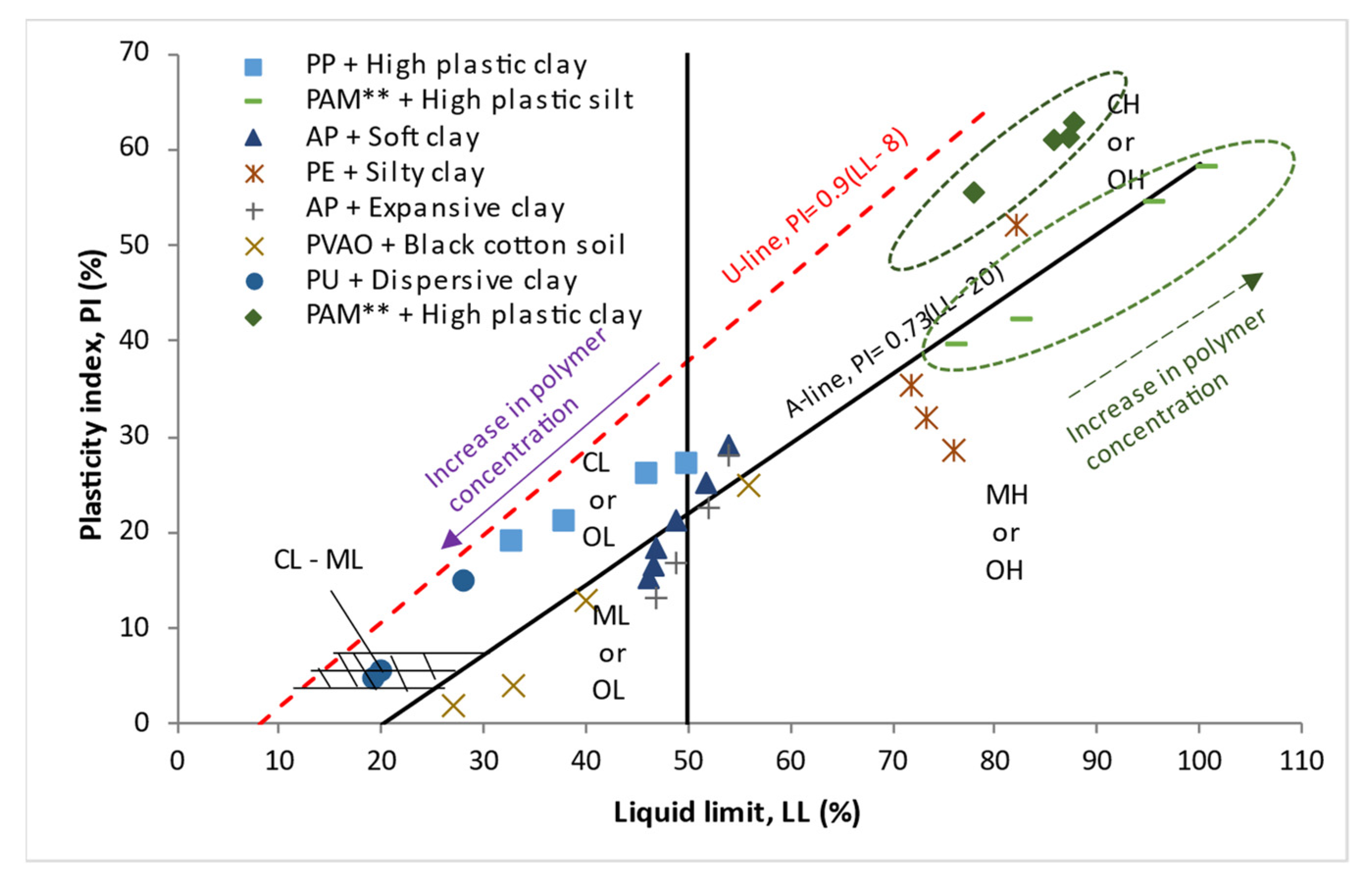

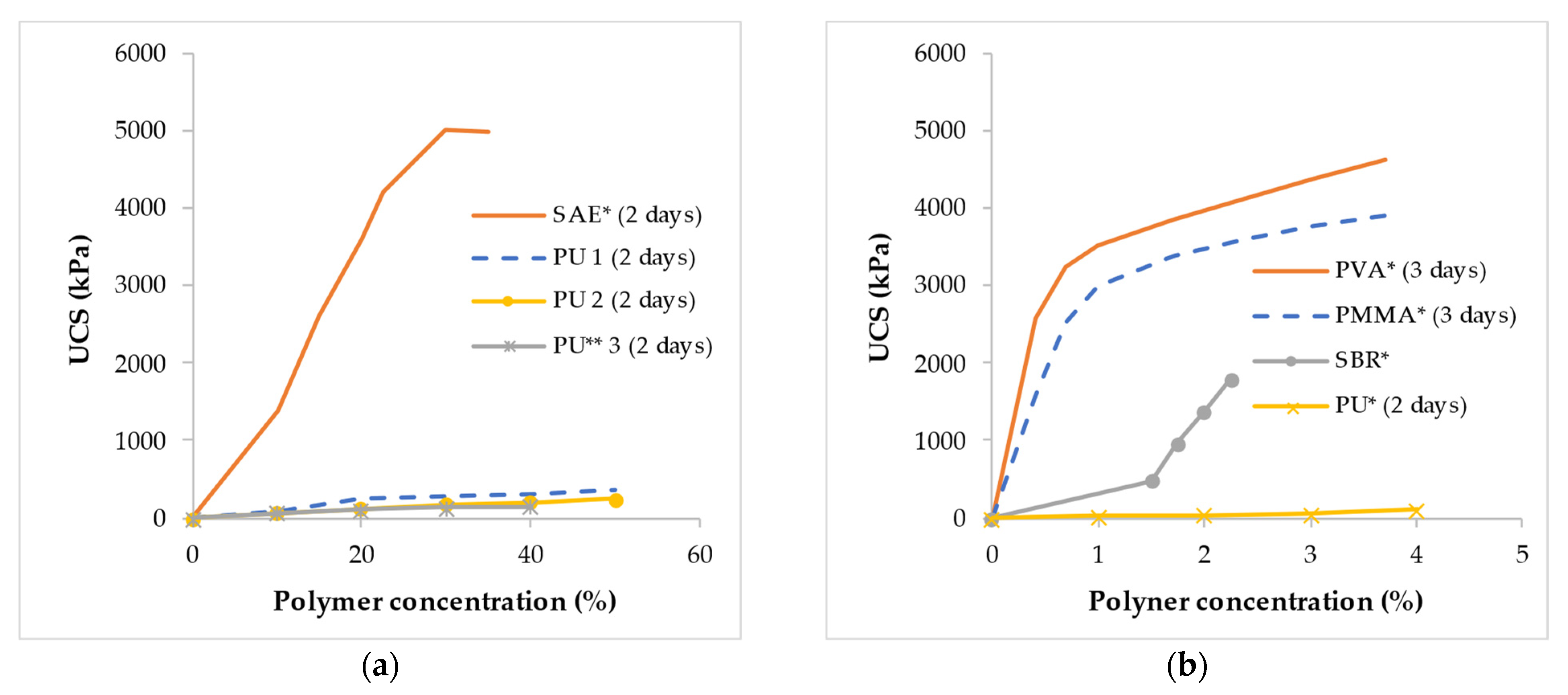

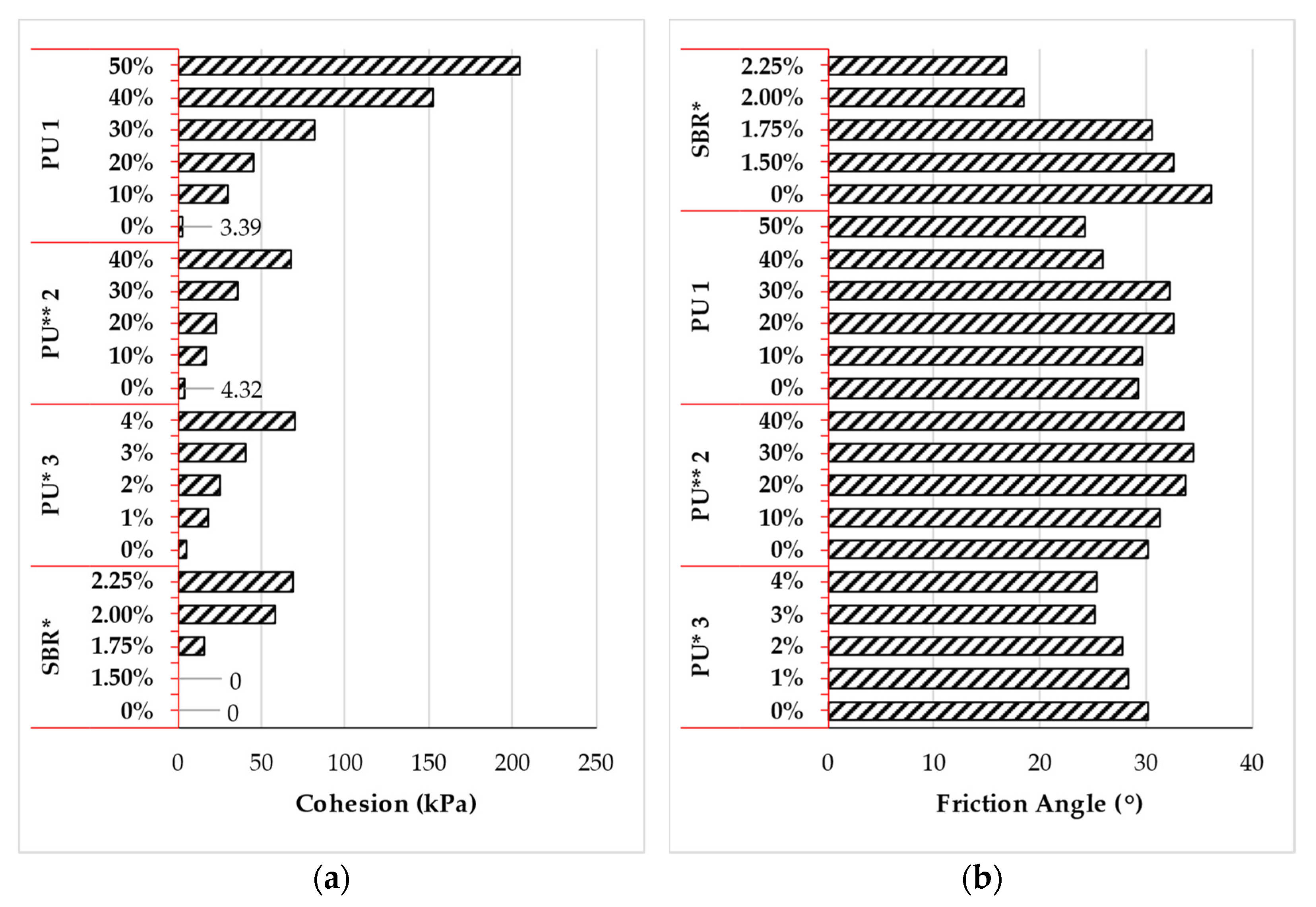
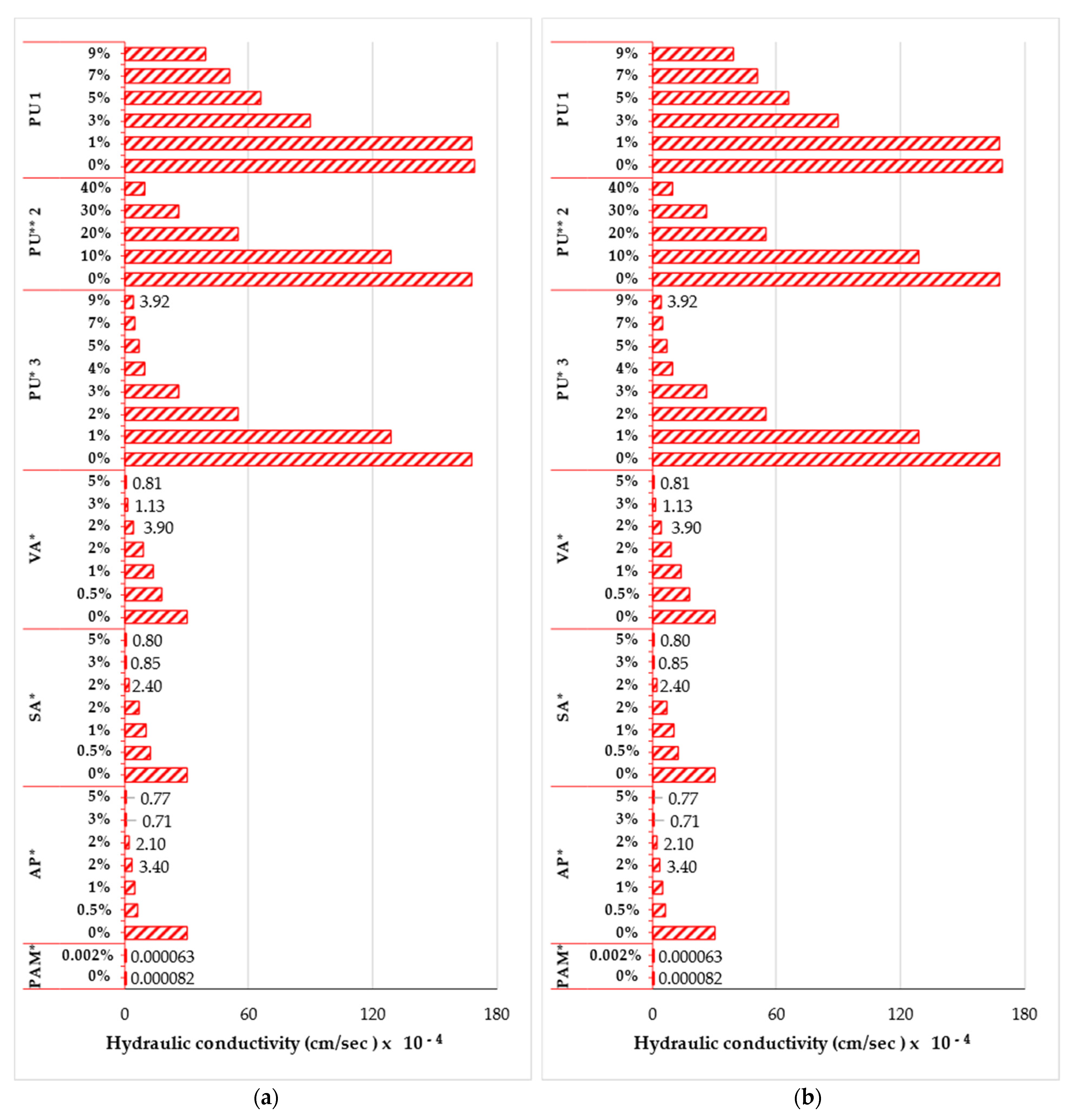
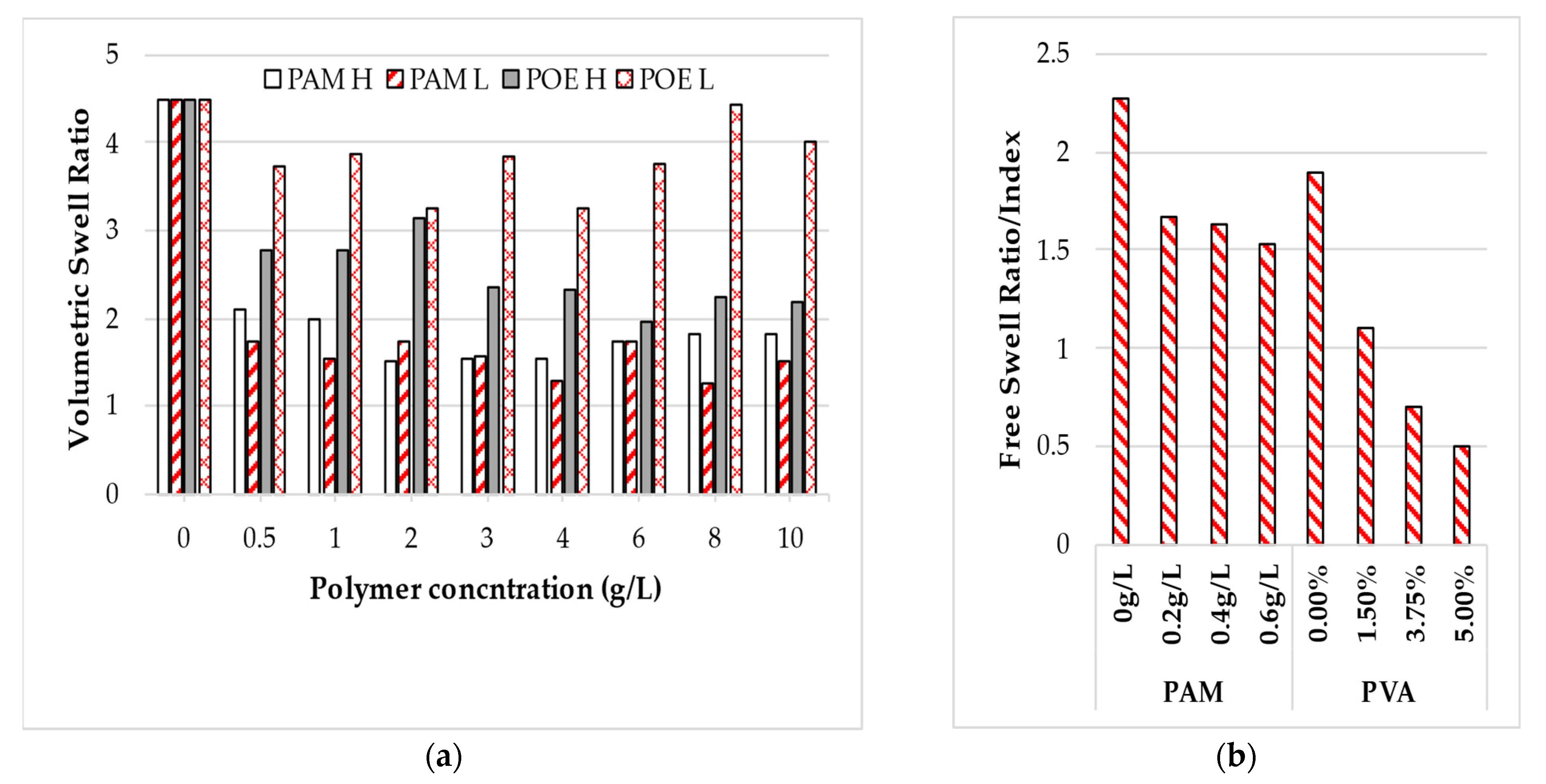

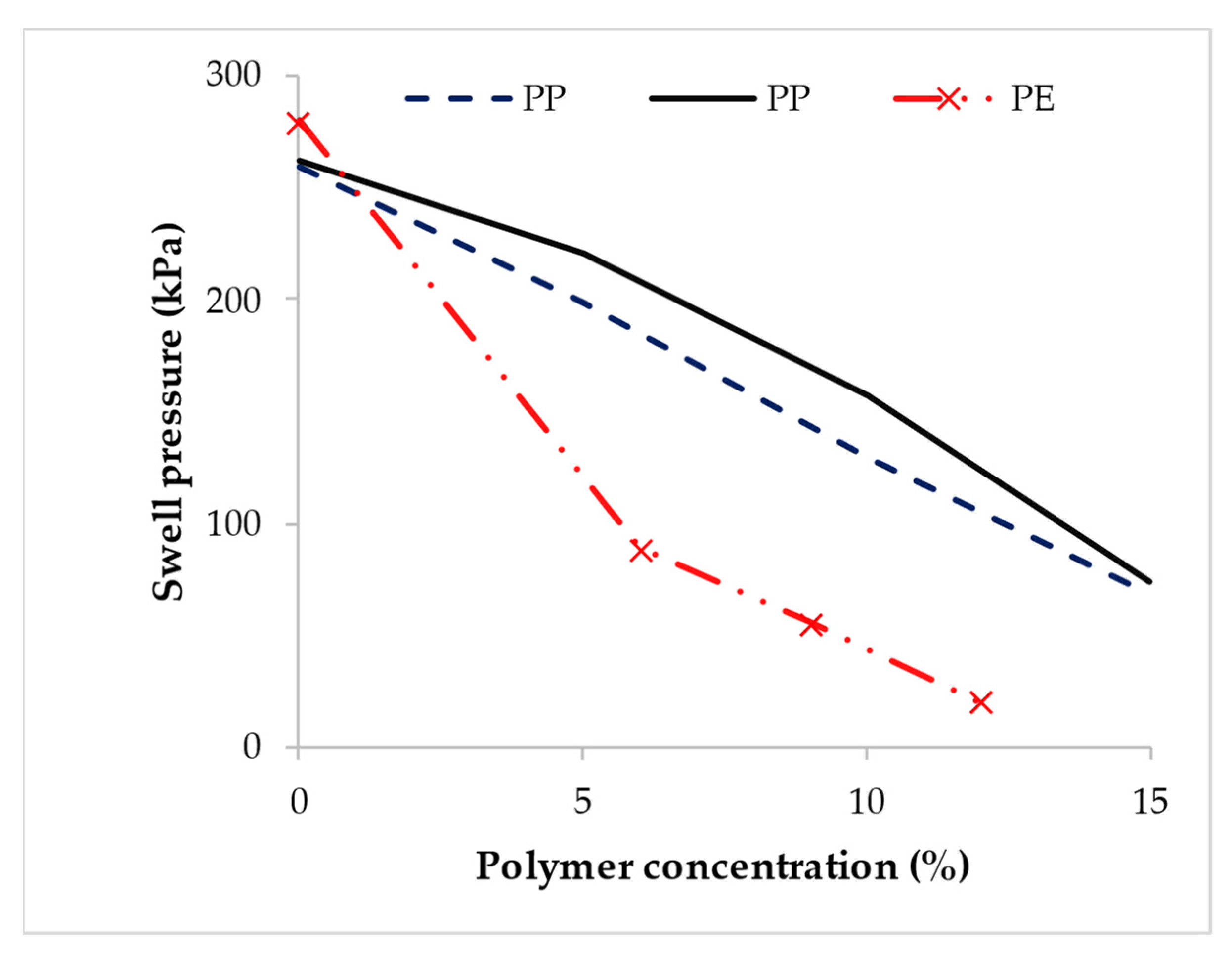
| Reference | Soil | Polymer Type | Polymer Content (%) | Penetration (mm) | CBR (%) |
|---|---|---|---|---|---|
| [95] | High plastic clay | CBR Plus | 0, 0.0096, 0.03, & 0.05. (% by weight of water) | 2.54 | 13, 22.4, 24.5, & 27.5 |
| RPP | 0, 0.019, 0.04, & 0.06 (% by weight of water) | 18, 21.7, 24.7, & 25.5 | |||
| [105] | Silty sand | Anionic PAM | 0, 0.001, 0.002, & 0.003 (% by weight of dry soil) | - | 19.05, 24.39, 25.03, & 23.31 (unsoaked) |
| 19.08, 18.35, 25.25, & 24.24 (Soaked) | |||||
| SAC | 0, 0.5, 0.7, & 1 (% by weight of dry soil) | 19.05, 23.88, 20.11, & 11.11 (unsoaked) | |||
| 19.08, 19.53, 18.35, & 9.68 (Soaked) | |||||
| [136] | High plastic clay | VC | 0, 0.5, 1, 1.5, & 3 (% by weight of dry soil) | 2.54 | 6.50, 11.40, 12.10, 14.70, & 12.50 (Unsoaked) |
| 5.08 | 7.13, 12.47, 13.07, 16.40, & 13.47 (Unsoaked) | ||||
| [143] | High plastic clay | HDPE | 0, 6, 9, & 12 | - | 5.5, 9.1, 15, & 21.5 |
| [131] | Sand | UFR | 0, 1, &2 (% by weight of dry soil) | - | 12.25, 20.10, & 25.35 |
| SBR | 0, 1, 2 & 3 (% by weight of dry soil) | 12.25, 6.59, 11.69, & 14.39 |
| Oedometer Swell (%) | Soil Expansivity |
|---|---|
| <1 | Negligible |
| 1–5 | Low (L) |
| 5–15 | Moderate (M) |
| 15–25 | High (H) |
| >25 | Very high (VH) |
| Reference | Soil | Polymer Type | Polymer Content (%) | Compression Index, Cc |
|---|---|---|---|---|
| [109] | High plastic clay | PVC | 0, 3, & 6 (% by weight of dry soil) | 0.33, 0.19, & 0.25 |
| HDPE | 0.33, 0.22, & 0.40 | |||
| [111] | Low plastic clay | PP | 0, 1.5, 3, & 5 (% by weight of dry soil) | 0.19, 0.14, 0.13, & 0.12 |
| [119] | Kaolin | MBA | 0, & 5% (% by weight of water) | 0.19, & 0.17 |
| STBA | 0.19, & 0.13 | |||
| PVA | 0.19, & 0.174 |
Publisher’s Note: MDPI stays neutral with regard to jurisdictional claims in published maps and institutional affiliations. |
© 2022 by the authors. Licensee MDPI, Basel, Switzerland. This article is an open access article distributed under the terms and conditions of the Creative Commons Attribution (CC BY) license (https://creativecommons.org/licenses/by/4.0/).
Share and Cite
Almajed, A.; Lemboye, K.; Moghal, A.A.B. A Critical Review on the Feasibility of Synthetic Polymers Inclusion in Enhancing the Geotechnical Behavior of Soils. Polymers 2022, 14, 5004. https://doi.org/10.3390/polym14225004
Almajed A, Lemboye K, Moghal AAB. A Critical Review on the Feasibility of Synthetic Polymers Inclusion in Enhancing the Geotechnical Behavior of Soils. Polymers. 2022; 14(22):5004. https://doi.org/10.3390/polym14225004
Chicago/Turabian StyleAlmajed, Abdullah, Kehinde Lemboye, and Arif Ali Baig Moghal. 2022. "A Critical Review on the Feasibility of Synthetic Polymers Inclusion in Enhancing the Geotechnical Behavior of Soils" Polymers 14, no. 22: 5004. https://doi.org/10.3390/polym14225004
APA StyleAlmajed, A., Lemboye, K., & Moghal, A. A. B. (2022). A Critical Review on the Feasibility of Synthetic Polymers Inclusion in Enhancing the Geotechnical Behavior of Soils. Polymers, 14(22), 5004. https://doi.org/10.3390/polym14225004










